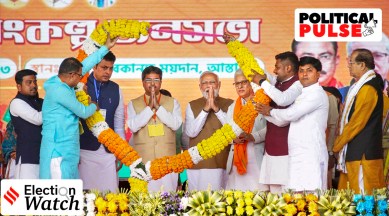Bengali concerns, tribal hopes, and a three-way race: The essential Tripura election primer
The BJP is banking on its governance record while the Left Front and the Congress will be hoping that their alliance will be enough to stop the ruling party in its tracks. But in the mix is Pradyot Debbarma’s TIPRA Motha.

Five years after the BJP ended the Left’s uninterrupted 25-year run in Tripura, the state is set for a three-cornered fight in the Assembly polls on Thursday, with the CPI(M)-Congress combine and the TIPRA Motha challenging the incumbent’s bid to retain power.
While the Left Front and the Congress are contesting under a seat-sharing arrangement to prevent any split in the Opposition vote, it is the TIPRA Motha, led by erstwhile royal family scion Pradyot Debbarma, that can potentially hold the levers of power after votes are counted on March 2.
monthly limit of free stories.
with an Express account.
The BJP, meanwhile, is banking on its track record in the government, playing up its “efficiency” and “transparency” in the delivery of public services and welfare schemes, as against the “discriminatory” nature of the previous regime led by the CPI(M) against families that did not endorse the Left.
Here is what you need to know about the politics of Tripura, India’s third-smallest state in terms of geographical area:
1) Tribal votes: In the 60-member Assembly, 20 seats are reserved for Scheduled Tribes. Once a tribal-majority kingdom, Tripura’s demographics saw a drastic shift between the pre-Partition years and 1971 — the year of the Bangladesh War of Liberation — due to a large influx of displaced Bengalis fleeing religious persecution.
The share of tribals in the total population has come down to 31.8 per cent as per the 2011 Census. It triggered a fierce ethnic conflict that has subsided now. But from time to time, indigenous outfits tap into the anxiety and resentment among the tribals against the hegemony of the Bengali community in the sphere of culture, politics, and administration. TIPRA Motha is the newest player that has captured the imagination of a large section of the tribals, distributed among 19 notified communities. While the party has fielded candidates in as many as 42 seats, its influence is largely limited to the ST-reserved constituencies. In the event of a hung Assembly, Pradyot will be the kingmaker.
2) Bengalis: Accounting for nearly 70 per cent of the state’s population, the Bengali community was divided between the Left and the Congress for a long time. While the Left made deep inroads among the working class population, apart from the intellectual class, the Congress continued to have strong pockets of influence in urban centres. That changed in 2018 with the emergence of the BJP, which swept to power, largely riding on the support extended by traditional Congress voters. With arch-rivals Left Front and Congress finalising a seat-sharing agreement this time, it will be interesting to see which way Bengalis tilt. The BJP feels that a large section of Bengali voters will not find the Left-Congress arrangement palatable. The BJP is also expecting that the concern generated by the rise of TIPRA Motha will lead to a consolidation of Bengali votes behind the party.
3) Erstwhile royal family: At the heart of Agartala, the state capital, stands the gleaming white Ujjayanta Palace, which was the seat of power of the Manikya dynasty that ruled the kingdom of Tripura or Twipra from the late 13th-Century until the signing of Instrument of Accession with the Union of India on October 15, 1949. While at least two members of the family — the last king Kirit Bikram Manikya and his wife Bibhu Kumari Devi — were elected to the Lok Sabha on Congress tickets, they were not prominent enough to swing elections. However, their son Pradyot enjoys massive popularity among the tribes owing to the traction that his demand for a “Greater Tipraland” has gained in recent years. He served as the working president of the Congress till September 2019.
4) Greater Tipraland: Initially, Pradyot maintained that “Greater Tipraland” would be a separate state carved out of Tripura to secure the rights, heritage, and culture facing threat from the hegemony of Bengalis. However, closer to the polls, he softened his position, saying he was essentially seeking a complete political separation of the areas under the Tripura Tribal Areas Autonomous District Council (TTADC) which can be achieved even without any territorial slicing. The TTADC was formed under the Sixth Schedule of the Constitution in 1985 to ensure the development and secure the rights and cultural heritage of tribal communities. It has certain legislative and executive powers. The TIPRA Motha claims that the TTADC is toothless and needs to be replaced with a more effective arrangement under a new “constitutional solution”.
5) History of Communism: The Communists started working in Tripura much before India’s independence. They primarily worked among the tribal communities, laying the building blocks of what would eventually be a formidable organisation. The Communists targeted the royalty, accusing it of keeping tribals impoverished. As a prelude to the entry of the undivided Communist Party of India, one organisation called the Tripura Janashiksha Samiti was launched to spread the light of education among the tribal masses. Dasarath Deb, who was among its leaders, would later (between 1993-1998( serve as the only tribal chief minister that the state has seen.